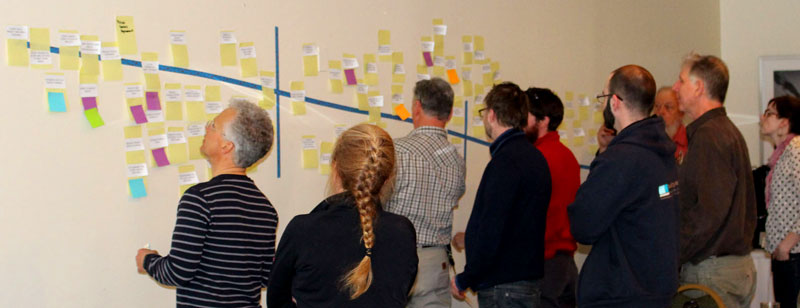Discovering Value in the Design/Build Workflow: New conversations for better relationships with Clients and Collaborators
Join us at the BE Bottom Lines Summit to explore this together
What should we “plan" to “build?" Design & Construction. We need the two to fit hand in glove. Yet I’ve been learning just how badly the goal of integrating them keeps falling short. We seem to be casting each of these roles in different versions of the same movie: Thrillers. Horror Stories. Slapstick Comedies! Maybe its time to recognize and value the roles designers and builders each play and figure out how to reward the value each of them provides to what turns out to be a rather complex equation. Let’s get them both acting together with a screenplay for a feel good film.
I facilitate one of the three BE Bottom Lines Networks (the others are facilitated by John Abrams and Paul Eldrenkamp). Twice a year ten NESEA member businesses gather at a host’s business location to learn together about our triple bottom lines. We focus on the host’s business and provide insights about their strengths and challenges. Between those meetings we correspond online.
One of the many strengths of this process is the opportunity to share business challenges with trusted colleagues and get their perspective and guidance in close to real time. From the start the same stories were being told over and over in each of these networks about failed relationships between designers and builders and their communication with each other and their clients. Confusion about budgets, scopes of work, systems of markup, and tales of betrayal, mistrust, mission creep, and unfortunate misunderstandings fuel these narratives. The more I listened to these stories and felt the frustration of these earnest business people the more interested I became in seeing if we all might find a way to do better. I will be facilitating a session with that intent at the upcoming BE Bottom Lines Summit at Smith College in Northampton on Nov. 4. If any of this resonates with you, in whatever role you may play in the process, please register and attend to join this conversation.

At a network gathering this spring we did an exercise together to map the design/build workflow, from first client contact to project completion. The goal was to reveal all the ways in which value is created and people are engaged to assure success. Once we had it mapped, we identified who served each action best and where collaboration between the designer and builder benefitted the process. We noted important milestones and where the client needed to respond to essential information. This was an eye opening experience for everyone. It was clear that each step in the process deserved the full attention of a collaborative team, whether or not those roles were served within a single company or by professionals with discrete responsibilities to design or build.

It became apparent that our actual experiences of this process were too often blind to the opportunities to collaborate. Poor communication and entrenched industry practices were undermining our ability to work together. This seems especially true of the still pervasive design/bid paradigm and the ways in which builders are cast as subservient, probably untrustworthy, and in need of strict supervision in order to “protect” the client. On the other hand, designers were being second guessed by builders who were short circuiting communication with their clients. Designers, while eager to work with good builders, and builders frustrated by some designers, were each often unwittingly setting the stage for the adversarial positions each party can become prone to adopt. Aggravated clients generated finger pointing and lip service to collaboration gave way to blame. Yikes!
A common response to these frustrations is to contemplate becoming a design/build company. While offering both services under one roof has many compelling virtues, most firms are equipped to do one or the other well while lacking the staff or experience to excel at both. For this reason I have a particular interest in inviting those folks with strengths in one domain to discover how to integrate their contribution to the total value proposition with those with strengths in the other without necessarily becoming full service design/build firms.
The foundation of design practice is not to start with a solution, but instead to observe the behavior of the system in order to learn enough to discover the means most likely to effect desired change. This is my premise for this journey (and I consider this a long term project and this session just one learning lab in that quest). What does an integrated design/build workflow require and what business models work to deliver that value? I’m hoping this session will serve those who should stick to what they do best (design or build) but want to collaborate better as allies, as well as those committed to delivering both together (design/build).
So let’s unfold and examine the complete design and construction workflow. Let’s identify the value provided in every step. Let’s ask who can best provide that value. Then let’s imagine the variety of roles to be played and how their collaboration increases value. In the light of what we observe let’s then ask two things: Which company structure best suits the value you provide, and how we can better organize the relationships and communication to produce the most satisfying result for everyone involved?
Join me and other Bottom Liners in Northampton to tackle these questions and imagine a better way to do business together.
Our Mission
NESEA advances sustainability practices in the built environment by cultivating a cross-disciplinary community where practitioners are encouraged to share, collaborate and learn.






Nadav at Building Green just turned me onto this architectural firm and their pursuit of a different way of working. An overview here: http://boiledarchitecture.com/how/ And extensive resources here (by all means watch the Prezi): http://boiledarchitecture.com/how-to-guides-and-resources/
And here is another great post from Boiled Architecture about IPD for small projects. Really interested in the shared risk idea and learning how that is institutionalized in a contract. http://boiledarchitecture.com/ipd-for-small-projects/
This really succinct outline of their process comes from EV Studio in Austin in a post titledThe Design-Build Project Delivery Process – Architect LedThe pre-construction services agreement allows the general contractor to work directly with the owner and EVstudio during project design providing “real time” feedback on cost consequences of design decisions based on current market conditions. The general contractor will “pre-bid” major components and systems of the project during the design process and offer advice regarding alternatives that may provide comparable performance at a lower cost. The general contractor can also provide valuable information on the constructability and predicted performance of numerous construction details based on experience and knowledge of the capabilities and limitations of available sub-contractors. By actively participating in the design of the project, the general contractor has the opportunity to familiarize himself with all the details of the project well before construction starts. This allows the general contractor to identify the critical path of the project, prepare a proactive construction schedule, and possibly even pre-order long lead time items while still in the design process. Most of all, the general contractor is able to work directly with the owner, architect, and the in-house engineers to assure the project is designed to its maximum potential in regards to the project budget. All of the bidding for the project is completed during the design process and value engineering decisions are immediately made based on current market conditions.Read the full post here:http://evstudio.com/the-design-build-project-delivery-process-architect-led/
Following our session exploring the Design/Build Workflow, I can't think of a better way for designers and builders to collaborate more effectively than for each to be participating together in a Bottom Lines network. Observing business operations in transparent detail, sharing and helping solve each others challenges, and gaining perspective thru the eyes of others inevitably results in the desire and ability to establish more fulfilling collaborative relationships in your practice. I'm hoping our next networks will have a healthy balance of designers and builders eager to learn from each other.For those who don't have that opportunity, my hope is that a better understanding of the value that each activity in the design build process provides, and who is best equipped to serve each activity, sets the stage for better conversations about who does what best and how each iteratively integrates with that capacity with the other.What would make a world of difference would be for designers to understand the reality of a builder's finances (most excel at the technical and struggle with the financial) and for builders to understand what it takes to faithfully manage the whole design process (and get paid for it)!Here's a link to the graphic of that workflow:DESIGN/BUILD WORKFLOW GRAPHIC